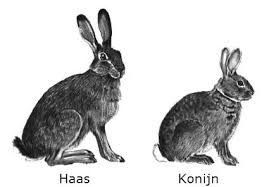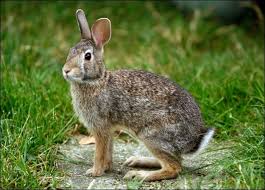The wild rabbit (Oryctolagus cuniculus) belongs to the family of Leporidae or lagomorphs.
Differences between the hare and rabbit
 The rabbit is much smaller than the hare.
The rabbit is much smaller than the hare.
The rabbit has shorter ears, no black spot at the tip. They have a brown tip. The ears reach folded forward not further than the head. While the hare does.
The legs of the rabbit are much shorter, it 's a sprinter.
The coat has a different structure than that of the hare. The belly is bluish gray in color, the underside of the tail is white, black and brown the top.
A rabbit remains near its burrow, a hare is a drifter who wanders further.
A rabbit digs pipes, a hare is sleeping in an undeep form (dimple).
Rabbits live in groups, hares solitary.
If a rabbit runs away (up to 55 km/ h) you can see the white underside of the tail whip.
For the hare (up to 75 km/ h) is the top of the tail dark. He keeps his tail down while running.
The droppings of a hare are generally lighter in color, larger, more flattened and fiber richer than that of a rabbit.
Leverets (baby hare) are nidifugous and born with open eyes and completely hairy and are readily able to run. Bunnies(baby rabbit) are bald, blind and helpless.
In birds, the extent to which they are independently shortly after hatching is marked with Precocial and Altricial (and gradations in between). Precocial: have feathers, eyes, flies after a few days and forages. Altricial (all songbirds): eyes closed, little or no down, have to be fed.
Rabbits are also "altricial", the young are born blind and hairless. Hares are "precocial" they are born with open eyes and coat. Young hares may very soon after birth take care of themselves.
Crosses between hare and rabbit are not possible because a hare has 48 chromosomes and a rabbit 44.
The body length is 35 to 45 centimeters, with a weight of one to two kilograms.
They live in self- dug, frequently branched burrows with multiple outputs. (A group of burrows is called a warren.) Therefore, they have a preference for a hilltop shelter on light soils, such as sand. The pipes have a diameter of about fifteen cm. The building is three meters deep, the total length of the pipes is more than 40 meters. At the main entrance there is a lot of ground. They provide lots of air holes.
The groups have an internal ranking.
The territory, with fixed tracks, is marked with droppings.
Rabbits are more vigilant as they move away from the burrow, then they eat and slower. This keeps the grass near the burrow shorter. They seldom venture further than 400 meters away from the cave. They are mainly active at dusk. The rabbit hops. They warn each other by drumming with the hind legs on the ground.
 The propagation time is from January to late June. If the doe (sexually mature at 6 months) is covered by the buck she kindles after 28 to 33 days a litter of 3 to 10 kittens (3 to 7 times / year with a minimum interval of thirty days). She makes a nest of hay and chest hair. The bunnies are 28 days visited 1 time per day for five minutes and nursed. After 10-12 days, the eyes open, and after two weeks they crawl around. Bunnies can already get kittens in their year of birth.
The propagation time is from January to late June. If the doe (sexually mature at 6 months) is covered by the buck she kindles after 28 to 33 days a litter of 3 to 10 kittens (3 to 7 times / year with a minimum interval of thirty days). She makes a nest of hay and chest hair. The bunnies are 28 days visited 1 time per day for five minutes and nursed. After 10-12 days, the eyes open, and after two weeks they crawl around. Bunnies can already get kittens in their year of birth.
They eat besides grasses, shoots, tubers, herbs, bark and field crops also their own feces directly from the rectum. This caecotrophy is a kind of rumination, a second stage after the first digestion.
RHD (Rabbit Haemmorhagic Disease) is known in Belgium since 1990. The rabbits stop eating and get bloody diarrhea followed by rapid death, usually with bleeding from the nose and body cavities. Cure is not possible.
The myxomatosis virus was intentionally distributed in Australia in 1950, and later in France, to curb the rabbits pests. Hm. (There were too much of them.) First you will see a swelling of the eyelids, mouth and anus. Then forming bumps (myxomen) all over the body. The rabbit goes sniffling, eyes sticking shut. Because the rabbit cannot eat it usually dies after two weeks.
